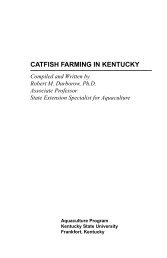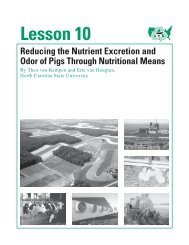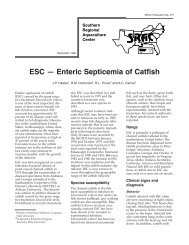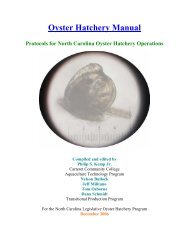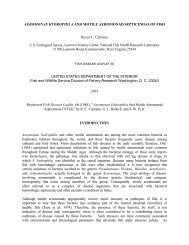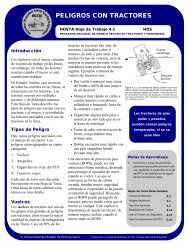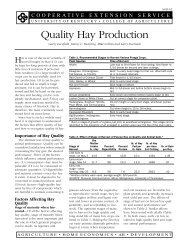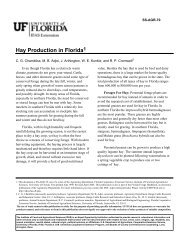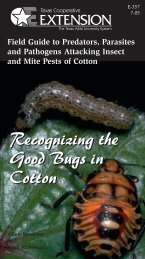Dryland Pastures in Montana and Wyoming - MSU Extension
Dryland Pastures in Montana and Wyoming - MSU Extension
Dryland Pastures in Montana and Wyoming - MSU Extension
Create successful ePaper yourself
Turn your PDF publications into a flip-book with our unique Google optimized e-Paper software.
Appendix A. (cont<strong>in</strong>ued)<br />
Native Cool-Season Grasses<br />
Idaho fescue<br />
Nezpurs<br />
Joseph<br />
Introduced Cool-Season Grasses<br />
Bunchgrass common <strong>in</strong> 15- to 19-<strong>in</strong>ch precipitation zone; prefers well<br />
dra<strong>in</strong>ed soils; poor seedl<strong>in</strong>g vigor.<br />
Quite variable <strong>and</strong> shorter than Joseph; equals Durar hard fescue <strong>and</strong><br />
exceeds Covar sheep fescue <strong>in</strong> forage production; Idaho release.<br />
Taller than Nezpurs <strong>and</strong> more uniform; better forage production than<br />
Covar sheep fescue or Durar hard fescue; Idaho release.<br />
16-18 <strong>in</strong>ches precipitation<br />
Meadow bromegrass Slightly rhizomatous; less apt to be sod bound than smooth bromegrass;<br />
excellent regrowth; compatible with legume component.<br />
Regar Rapid seed germ<strong>in</strong>ation; lax basal leaves; good regrowth; excellent hay<br />
or pasture; Idaho 1966.<br />
Timothy<br />
Fleet<br />
Paddock<br />
Superior seedl<strong>in</strong>g vigor, seed quality <strong>and</strong> production as compared to<br />
Regar; Agriculture Canada 1987.<br />
Similar forage yields to Fleet <strong>and</strong> Regar; lower seed yield than Fleet;<br />
Agriculture Canada 1987.<br />
<strong>Montana</strong> Fast recovery after cutt<strong>in</strong>g; higher seed yield than Regar; <strong>Montana</strong> 2000.<br />
MacBeth Fast regrowth; higher seed yield than Regar or Paddock; <strong>Montana</strong> 2002.<br />
Climax<br />
Drummond<br />
Orchardgrass<br />
Latar<br />
Potomac<br />
Kentucky bluegrass<br />
Troy<br />
Bunchgrass with a bulblike base; often used follow<strong>in</strong>g timber harvest.<br />
Tall; f<strong>in</strong>e stemmed; leafy; regrowth excellent under good fertility;<br />
Canada 1947.<br />
Later matur<strong>in</strong>g; slightly <strong>in</strong>ferior to Climax <strong>in</strong> mid-summer regrowth;<br />
Canada 1940.<br />
Bunchgrass, very palatable forage; pasture or hay; easy to establish;<br />
excellent regrowth; poor w<strong>in</strong>ter hard<strong>in</strong>ess without snow cover; late <strong>and</strong><br />
early matur<strong>in</strong>g cultivars; cultivar selection should be based on environment<br />
<strong>and</strong> maturity should co<strong>in</strong>cide with legume component of mix.<br />
Often used follow<strong>in</strong>g timber harvest or burn; late maturity date corresponds<br />
with alfalfa hay; excellent irrigated cultivar; w<strong>in</strong>ter hardy where<br />
snow cover lasts the entire w<strong>in</strong>ter; Idaho <strong>and</strong> Wash<strong>in</strong>gton 1957.<br />
Preferred <strong>in</strong> higher elevations with short grow<strong>in</strong>g seasons; early maturity<br />
matches legumes; Oregon 1954.<br />
Introduced cool-season, sod-form<strong>in</strong>g grass; primarily used for recreational<br />
turf <strong>and</strong> erosion control; low forage production; withst<strong>and</strong>s<br />
heavy graz<strong>in</strong>g use.<br />
Introduced from Turkey; upright forage type bluegrass; earlier than<br />
crested wheatgrass or Russian wildrye but not as productive <strong>in</strong> spr<strong>in</strong>g<br />
pastures; <strong>Montana</strong>.<br />
— 31 —





